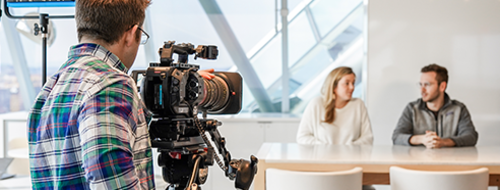At Nestlé, our climate goals are ambitious: we aim to achieve Net Zero emissions by 2050 and have a detailed plan to get there. We believe that we can use our size and scale to help transform the food system and our communities for the better. To do this, we’re activating our passionate, innovative people to drive change in all areas of the business – from farming, to packaging, to how we make and transport our foods.
When you buy your favorite Nestlé products, you should feel confident that we are putting in the work to make that product both delicious and more sustainable. From Libby’s pumpkin to Coffee mate creamers, and Gerber baby food to Nestlé Purina pet food, many of our most popular brands are tackling big picture climate commitments with concrete action that can make an impact.
Ultimately, our goal is to leave the world better than we found it. It’s going to take real work across our organization to achieve that ambition – here are just some of the ways we’ve already made progress, and where you might even be able to see that work in your kitchen today.
Partnering with Farmers to Drive Regenerative Agriculture
Our work toward a more sustainable future begins on the farm: our ingredients represent the largest proportion of our carbon footprint, and our biggest opportunity to have a positive impact on climate. This means working with farmers on regenerative farming practices that replenish the land and enhance the health of the environment.
By using reduced tillage practices, Libby’s pumpkin farmers saved the equivalent of 43 dump trucks of soil from being lost to erosion in 2021, as compared to conventional practices. And through Nescafe’s 2030 Plan and Nespresso’s AAA Program, we are working with farmers to equip them with the skills to help ensure the health of coffee farms for future generations.
As part of the Nestlé family, Sweet Earth is a leader in plant-based innovation across our U.S. portfolio, and brands like natural bliss and Starbucks Creamers are also offering plant-based options. Alongside Cargill, we’ve collaborated with the National Fish and Wildlife Foundation to help scale the adoption of voluntary conservation practices that help fight climate change. This work will help generate carbon benefits across more than 15 states, including areas in the Great Plains, Mountain West, Midwest and Southeastern portions of the U.S.
Evolving the Ways We Make and Transport our Food & Beverages
We’re also working to reduce emissions in our own operations, to help ensure the facilities where we produce beloved brands such as DiGiorno, Stouffer’s and Nesquik are doing so in a sustainable way.
All Nestlé facilities across the U.S. will be using 100% renewable electricity by 2025, and we’ve already taken great steps to achieve this goal. As of 2022, more than 80% of Purina’s electricity came from renewable sources such as wind farms and solar. We have also invested in two large-scale solar projects in Texas – the Taygete I Solar Project and the Ganado Solar Project - that collectively will represent nearly 50% of Nestlé’s electricity in the U.S.
Innovative work in our factories also drives positive climate action. For example, our Nescafé factories burn waste coffee grounds to make steam that makes our granules, and our Libby’s factory in Morton, IL recycles pumpkin by-products and incinerates remaining waste for energy recovery. Additionally, our new factory in Glendale, AZ is being designed with sustainability at the forefront: we are implementing a water recycling process to help conserve water and use it as efficiently as possible, the facility is being built to run on 100% renewable energy, and all bottles coming out of the facility will be fully recyclable.
Making Our Packaging Recyclable, By Design
Ultimately, our ambition is to make 100% of our packaging recyclable or reusable – to do this we’re unlocking the innovation and passion of our teams. We’re designing our packaging to use fewer materials, incorporating more recycled content, and testing alternative materials to improve recyclability. Most importantly, we’re never compromising on the quality and safety of your favorite brands.
Our 46 ounce natural bliss bottle is fully recyclable and made with 100% recycled plastic, making it the first bottle in the coffee enhancer space that is 100% post-consumer recycled. Nestlé Purina’s Tidy Cats Naturally Strong 100% natural litter comes in jugs made with 50% recycled plastic, eliminating over 375,000 pounds of virgin plastic in one year. Select Gerber Organic puree products come in the IncrediPouch™, the category’s first-of-its-kind, single-material baby food pouch designed to promote the circular economy. Nespresso packages its coffee in aluminum capsules—an infinitely recyclable material—and offers more than 100,000 collection points for them.
To help modernize recycling infrastructure in the U.S., we’ve invested $30 million in the Closed Loop Leadership Fund to help upgrade recycling infrastructure and expand the availability of recycled content, and Nespresso invested $1.5M to improve the NYC curbside recycling infrastructure. We also recently invested in Circular Services, a leading developer of circular economy and recycling infrastructure in the U.S.
We know no one company can do this work alone. Building a more sustainable future involves working collaboratively with organizations, partners, customers, and our employees, driven by a shared desire to make a real impact. To achieve Net Zero by 2050 we’ll continue innovating across our business and sharing our progress so you can see the real-time impact of our work.







